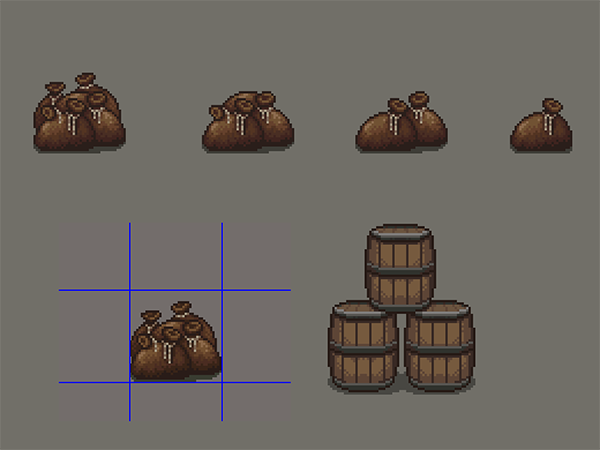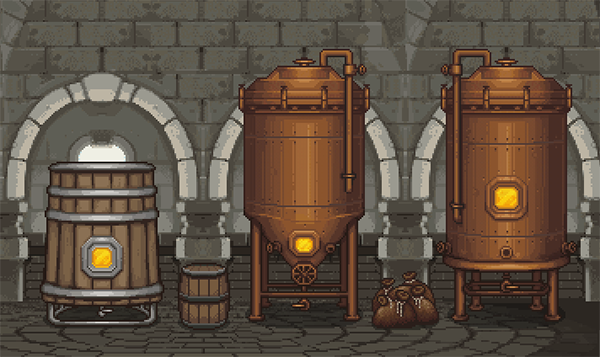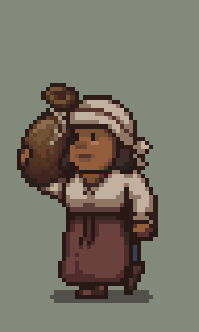Almost 100 Something's Brewings now...
This week we kept working on our most recent focal point, the Superiors' room/office, as well as perfecting the sacks found in the Abbey's breweries and storage rooms, and - hopefully - not sprawled all over the monastery... to do so, work on the Laymen/women also followed suit!
Oh and if you want a hint about what's coming next, a new page showed up in our collab tools ;)

You got that right, bandit shenanigans are underway!
-- What comes after barrels?
Sacks. That's the answer, sacks. We have been working on barrels for so long it feels refreshing to work on something not made out of wood. The "other" way of transporting stuff in the Abbey, and more specifically ingredients and supplies from the Merchant to the Abbey's Brewery or its Pantry.
Raimo has been working on sizes and stacks and it seems that the work progresses as one would expect.

Already testing them in-game, we can see they are already a good fit with their environment and consistent with the rest of the equipment (if not even a bit sus!🕵️)

-- New animations
Along with the work on the sacks, our pixel artist Raimo also worked extensively on the Laymen/women carrying and working on said sacks.



Still WIP, especially with all the information going back and forth regarding the way supplying and resupplying will work in the backend (between Brews and ingredients coming from the Merchant). More to come of course.
-- Abbey's Superiors' room extras
And the "eye-candyiest" part of today's Something's Brewing, this week's additions to the Superiors' office.
First and foremost after considering the options of an open/closed bed, we went for the more intriguing closed one, investing in luxury and maybe adding a bit of playful mystery.

Adding to that, we also started animating the use of the desk found in the room, with both versions, either used by the Abbess or the Abbot.


-- Overfermentation, the silent killer!
A veteran battle-scarred homebrewer would know how far they can push their wort, bend it to their will, and give it the characteristics they're seeking. For the rest of us, exceeding some limits of a fermenting beer would most probably end up in disaster. And that disaster comes in many forms too... If you over-ferment your wort you risk getting:
- Off-flavors: Extended fermentation can result in the production of off-flavors such as higher alcohols, esters, and phenols. These compounds can contribute unpleasant tastes and aromas, often described as solvent-like, fruity, or medicinal.
- Dryness: Overfermentation can lead to excessive attenuation, meaning that more fermentable sugars are consumed by yeast, resulting in a drier beer with a lower residual sweetness.
- Thinning of body: Extended fermentation may reduce the body and mouthfeel of the beer, making it feel thin and lacking in the characteristic mouth-coating properties associated with certain beer styles.
- Loss of hop character: Overfermentation can diminish hop flavors and aromas, particularly in hop-forward beer styles. This can result in a beer that lacks the desired balance between malt sweetness and hop bitterness.
- Carbonation issues: If the beer is over-fermented before bottling, there may be insufficient residual sugars for natural carbonation during bottle conditioning. This could result in flat beer, requiring additional priming sugar to achieve the desired carbonation level.
- Yeast autolysis: Prolonged exposure to yeast in the fermenter can lead to autolysis, where yeast cells break down and release compounds that can contribute off-flavors such as meaty or rubbery notes.
Good thing is, all of the above can be easily avoided. Read the information that comes with your yeast, barley, and any additives. It's good to know, but the secret is, don't depend on that information alone. Instead, monitor the fermentation process closely, paying attention to factors such as i) fermentation temperature, ii) yeast health, and iii) original gravity while the magic is happening. Using a hydrometer or refractometer to measure gravity regularly can help determine when the fermentation is complete, allowing you to rack the beer to secondary vessels or proceed with bottling at the appropriate time. No harm, no foul!
Enjoy your weekend responsibly, and join us next week for some more Ale Abbey news!
-- Hammer & Ravens
Craving for more Ale Abbey? Or maybe you want to chat with the team and our community? Find us on:





